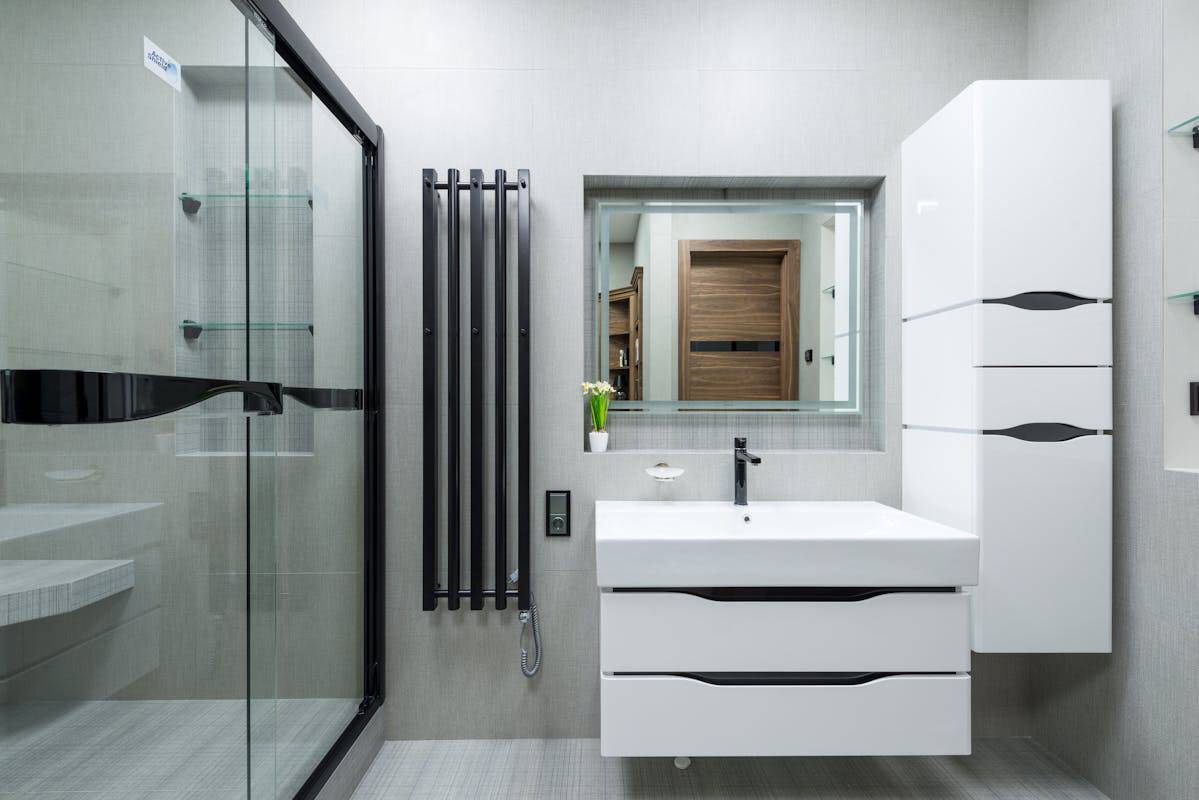Welcome to our informative article on the best sustainable bathroom materials to help you create an eco-friendly upgrade for your space.
If you’re looking to make your bathroom more environmentally conscious, incorporating sustainable materials is a great place to start.
From recyclable options to durable and low-impact choices, there are various materials available that not only contribute to a greener planet but also offer functionality and style.
Table of Contents
Recycled Glass Countertops
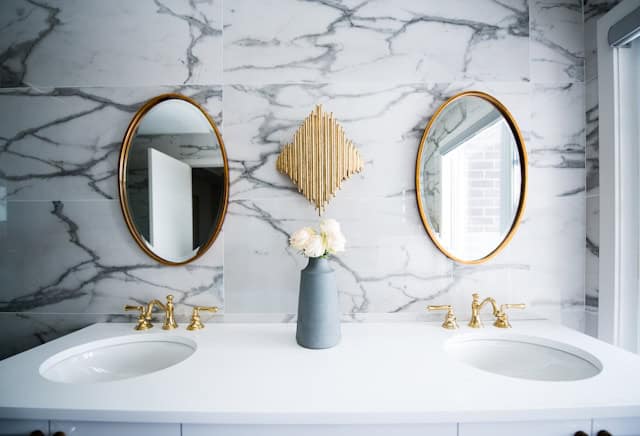
When it comes to sustainable bathroom materials, recycled glass countertops are an excellent choice. These countertops are not only visually appealing but also contribute to waste reduction and support recycling efforts.
Made from recycled glass, these countertops help divert glass waste from landfills, giving it a second life. By opting for recycled glass countertops, you not only promote sustainability but also add a unique and eco-friendly touch to your bathroom.
Recycled glass countertops are not just beautiful; they are also highly durable and easy to maintain. Unlike their traditional counterparts, they are resistant to heat, stains, and scratches, making them ideal for a busy bathroom environment.
With a wide range of colors and patterns available, recycled glass countertops offer versatility in design. You can choose from vibrant, bold hues or subtle, neutral tones, allowing you to create a bathroom space that reflects your style and taste.
Using recycled glass countertops is a sustainable choice that combines aesthetics, durability, and environmental consciousness. It’s a win-win situation for both you and the planet.”
Not only do these countertops minimize waste and support recycling, but they also contribute to indoor air quality. The manufacturing process uses low-VOC (volatile organic compound) binders, ensuring that your bathroom remains a healthy and eco-friendly space.
When it comes to maintenance, recycled glass countertops are incredibly easy to clean. Just a simple wiping with a mild soap and water solution is enough to keep them looking pristine. Additionally, their non-porous surface prevents the growth of bacteria and mold, ensuring a hygienic bathroom environment.
Sustainability at its Best
Recycled glass countertops are a shining example of sustainable bathroom materials. They offer a beautiful, durable, and low-maintenance solution while minimizing waste. By choosing recycled glass countertops, you are not only making an eco-friendly choice but also contributing to a more sustainable future.
| Benefits of Recycled Glass Countertops | Drawbacks of Recycled Glass Countertops |
|---|---|
| Environmentally friendly Durable and heat-resistant Easy to maintain and clean Wide range of colors and patterns | Higher cost compared to some other materials May have visible seams Requires careful handling to prevent chipping |
Bamboo Flooring
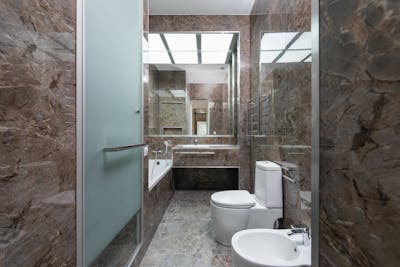
Bamboo flooring is a sustainable and eco-friendly option to consider for your bathroom. With its numerous environmental benefits, it has gained popularity as an alternative to traditional hardwood flooring.
Bamboo is a fast-growing, renewable resource that regenerates much faster than other types of wood. It can reach maturity in as little as 3-5 years, making it an excellent choice for those looking for environmentally friendly options.
The production of bamboo flooring requires less energy and resources compared to traditional hardwood. This means a reduced carbon footprint and a positive impact on the environment. By using bamboo flooring in your bathroom, you can contribute to sustainable living while enjoying a durable and long-lasting flooring option.
In terms of durability, bamboo flooring is known for its strength and resilience. It is resistant to moisture, which is essential for bathroom environments. Its natural properties make it less prone to warping and swelling, ensuring that your bamboo flooring will withstand the demands of daily use.
When it comes to style, bamboo flooring offers a natural and elegant look to your bathroom. It adds warmth and beauty to the space while providing a comfortable and inviting atmosphere. Whether you prefer a modern or traditional design, bamboo flooring can complement various interior styles.
Furthermore, bamboo flooring is easy to maintain. Regular sweeping and occasional damp mopping are usually sufficient to keep it clean and in good condition. Its smooth surface makes it resistant to spills and stains, making it an ideal choice for a bathroom where water and moisture are common.
Bamboo flooring provides a sustainable and stylish option for your bathroom, contributing to a greener environment without compromising on design or functionality.
Benefits of Bamboo Flooring
- Fast-growing and renewable resource
- Low environmental impact
- Durable and resilient
- Moisture-resistant
- Natural and elegant look
- Easy to maintain
| Advantages of Bamboo Flooring | Disadvantages of Bamboo Flooring |
|---|---|
| Environmentally friendly | Can be prone to scratches |
| Durable and long-lasting | May darken or fade over time |
| Moisture-resistant | Requires proper sealing in high-moisture areas |
| Wide range of styles and finishes | May be more expensive than some other flooring options |
Overall, bamboo flooring is an excellent eco-friendly choice for your bathroom. It combines sustainability, durability, and style to create a beautiful and long-lasting flooring solution.
Water-Saving Fixtures
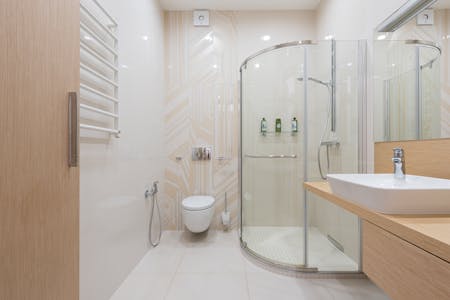
When it comes to creating a sustainable bathroom, water-saving fixtures are a must-have. By installing low-flow faucets, showerheads, and toilets, you can significantly reduce your water consumption without sacrificing performance. These fixtures not only help conserve water but also contribute to an eco-friendly and cost-effective bathroom design.
Low-flow faucets are designed to provide a steady stream of water while using less water per minute compared to traditional faucets. This means you can still enjoy a refreshing handwash or quick face clean without wasting excessive amounts of water.
“Installing water-saving fixtures in your bathroom is a small yet impactful step towards sustainable living.”
Similarly, low-flow showerheads offer a gentle yet invigorating shower experience while using less water. These showerheads utilize innovative technologies that maintain water pressure while reducing flow, making them an excellent choice for those looking to conserve water without compromising on comfort.
When it comes to toilets, opting for water-saving models can have a significant impact on your water consumption. Dual-flush toilets allow you to choose between a full flush or a half flush, depending on your needs. This flexibility ensures efficient water usage, as you can use the full flush for solid waste and the half flush for liquid waste.
Innovative Water-Saving Technologies
With advancements in technology, manufacturers have introduced innovative water-saving features that enhance the efficiency of these fixtures. Some faucets and showerheads are equipped with aerators that mix air with water, creating a steady stream while reducing water output. Additionally, smart toilets come with sensors that adjust flushing power based on usage, further optimizing water usage in the bathroom.
Make a Difference with Water-Saving Fixtures
By incorporating water-saving fixtures into your bathroom, you can make a positive impact on the environment and save on your water bills. The table below highlights the potential water savings you can achieve with these fixtures:
| Fixture | Water Savings |
|---|---|
| Low-flow faucet | Save up to 30% on water usage |
| Low-flow showerhead | Save up to 50% on water usage |
| Dual-flush toilet | Save up to 50% on water usage |
As you can see, water-saving fixtures provide significant water savings without compromising performance. By incorporating these fixtures into your bathroom design, you can contribute to water conservation efforts and create a sustainable living space.
Natural Stone Tiles
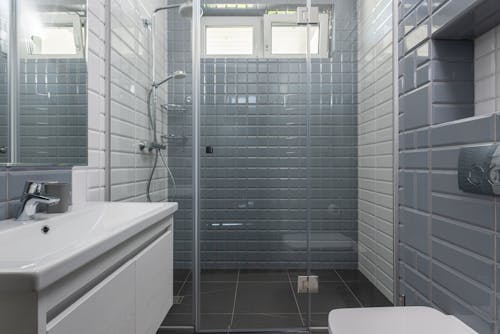
When it comes to sustainable bathroom materials, natural stone tiles are an excellent choice for both the walls and floors. Stones like marble, granite, and travertine offer not only a stunning aesthetic but also a sustainable option that can be responsibly sourced.
By opting for natural stone tiles, you are utilizing a natural resource that is abundant and can be extracted with minimal impact on the environment. These stones are formed over thousands of years, making them a truly renewable and eco-friendly choice for your bathroom.
What sets natural stone tiles apart is their durability. They are built to last, ensuring that your bathroom will maintain its beauty and functionality for years to come. Additionally, natural stone tiles are low-maintenance, requiring only regular cleaning to keep them looking their best.
“Natural stone tiles provide a beautiful and sustainable option for bathroom walls and floors. Stones like marble, granite, and travertine are natural resources that can be responsibly sourced.”
When it comes to design versatility, natural stone tiles shine. Their unique patterns, colors, and textures add a touch of elegance and sophistication to any bathroom. Whether you prefer a modern, minimalist look or a more traditional aesthetic, natural stone tiles can be adapted to suit your style.
Benefits of Natural Stone Tiles:
- Responsibly sourced from natural resources
- Durable and long-lasting
- Low-maintenance
- Design versatility
When installing natural stone tiles in your bathroom, it is essential to consider proper sealing and maintenance to enhance their longevity. Sealing the tiles helps prevent stains and water damage, ensuring that they remain in optimal condition over time.
| Pros | Cons |
|---|---|
| 1. Sustainable and responsibly sourced | 1. Require professional installation |
| 2. Durable and long-lasting | 2. Can be more expensive than other options |
| 3. Low-maintenance | 3. May require periodic sealing |
| 4. Design versatility | 4. Cold underfoot, may require radiant heating |
Recycled Fixtures and Accessories
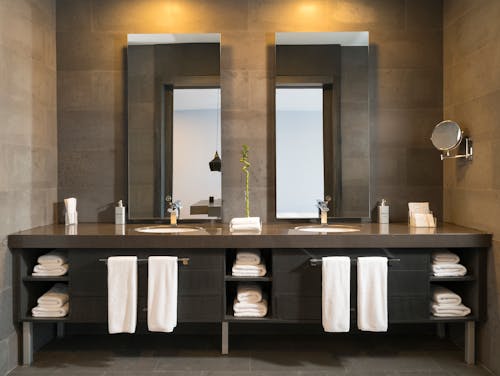
When designing a sustainable bathroom, incorporating recycled fixtures and accessories is a smart choice that helps reduce waste and contribute to a greener environment. By opting for recycled metal or glass fixtures like faucets, showerheads, and towel racks, you can add a touch of elegance to your bathroom while promoting sustainability.
Using recycled materials for accessories such as mirrors and storage containers not only adds a unique charm to your space but also reduces the demand for new resources. These recycled accessories showcase creativity and style, making them the perfect finishing touches for your sustainable bathroom design.
“Sustainable bathroom design encompasses not just the big-picture elements like flooring and countertops but also the smaller details like fixtures and accessories. By choosing recycled options, you can make a meaningful impact on the environment without compromising on style.”
Recycled fixtures and accessories not only contribute to waste reduction but also help you create a bathroom with character and personality. Each recycled piece tells a story of its own, adding a sense of authenticity and uniqueness to your space.
When shopping for recycled fixtures and accessories, consider visiting local eco-friendly home improvement stores or exploring online marketplaces that specialize in sustainable products. This way, you can support businesses that prioritize environmental responsibility and find one-of-a-kind pieces that align with your sustainable bathroom vision.
Remember, making sustainable choices doesn’t mean compromising on style or functionality. By embracing recycled fixtures and accessories, you can create a bathroom that is both eco-friendly and aesthetically pleasing.
A Comparison of Recycled Fixture and Accessory Options
| Fixture/Accessory | Description |
|---|---|
| Recycled Glass Faucet | A stunning centerpiece for your bathroom sink, made from recycled glass bottles and meticulously crafted to elevate your space. |
| Upcycled Metal Showerhead | A combination of functionality and sustainability, made from salvaged metals to minimize environmental impact while delivering an invigorating shower experience. |
| Reclaimed Wood Mirror | A beautiful statement piece, crafted from reclaimed wood sourced from old buildings or furniture, adding warmth and character to your bathroom. |
| Recycled Plastic Storage Containers | Stylish and functional storage solutions made from recycled plastic, offering organization while reducing plastic waste. |
Conclusion
In conclusion, designing a sustainable bathroom is good for your health as well as the environment. You may enhance your space in an eco-friendly way that is both fashionable and long-lasting by using materials like recycled glass countertops, bamboo flooring, water-saving fixtures, natural stone tiles, and recycled fixtures and accessories.
Recycled glass countertops are a waste-reducing and aesthetically pleasing surface for your bathroom that requires no upkeep. Strong and long-lasting bamboo flooring provides a sustainable substitute for conventional hardwood. Water-saving fixtures minimize water usage without sacrificing functionality, and natural stone tiles offer longevity and beauty made from materials that are responsibly produced. Recycled accessories and fixtures finish off your eco-friendly bathroom design and cut down on waste.
Take these into account while remodeling or decorating your bathroom to help the environment. You may create a setting that displays your dedication to the environment and help create a greener future by selecting environmentally friendly fixtures and materials. Convert your bathroom into a sustainable haven and reap the long-term rewards of a chic, green renovation.
What are sustainable bathroom materials?
Sustainable bathroom materials are environmentally friendly options that minimize waste, conserve resources, and promote long-term sustainability. These materials are often made from recycled or renewable materials and have minimal impact on the environment throughout their lifecycle.
Why should I choose sustainable bathroom materials?
Choosing sustainable bathroom materials is beneficial for several reasons. Firstly, they help reduce your carbon footprint and contribute to a healthier environment. Secondly, sustainable materials are often more durable and require less maintenance, saving you money in the long run. Lastly, using eco-friendly materials can enhance the overall aesthetic of your bathroom, creating a stylish and modern space.
What are some examples of sustainable bathroom materials?
Some examples of sustainable bathroom materials include recycled glass countertops, bamboo flooring, water-saving fixtures, natural stone tiles, and recycled fixtures and accessories. These options are not only visually appealing but also contribute to a more sustainable and eco-friendly bathroom design.
Are recycled glass countertops a good choice for my bathroom?
Yes, recycled glass countertops are an excellent choice for a sustainable bathroom. They are made from recycled glass, which helps reduce waste and supports recycling efforts. Recycled glass countertops are also durable, easy to maintain, and visually appealing, making them a stylish and eco-friendly option.
Why is bamboo flooring considered a sustainable option for bathrooms?
Bamboo flooring is considered a sustainable option for bathrooms because bamboo is a fast-growing and renewable resource. It requires less energy and resources to produce compared to traditional hardwood. Bamboo flooring is known for its strength, durability, and water resistance, making it ideal for a bathroom environment.
How do water-saving fixtures contribute to a sustainable bathroom?
Water-saving fixtures, such as low-flow faucets, showerheads, and toilets, significantly reduce water consumption in your bathroom. These fixtures are designed to conserve water without compromising performance, helping you save on water bills and contribute to water conservation efforts. Installing water-saving fixtures is a simple yet effective way to create a more sustainable bathroom.
What are the benefits of using natural stone tiles in a bathroom?
Natural stone tiles offer numerous benefits for bathrooms. They provide a beautiful and timeless aesthetic, are durable and long-lasting, and require minimal maintenance. Stones like marble, granite, and travertine are natural resources that can be responsibly sourced. By choosing natural stone tiles, you can create a sustainable and visually appealing bathroom space.
How can I incorporate recycled fixtures and accessories in my bathroom?
Incorporating recycled fixtures and accessories in your bathroom is a simple way to reduce waste. Opt for fixtures like faucets, showerheads, and towel racks made from recycled metal or glass. Additionally, utilize recycled materials for accessories such as mirrors and storage containers. By choosing recycled options, you can complete your sustainable bathroom design while minimizing your environmental impact.
How can I create a sustainable bathroom design?
Creating a sustainable bathroom design involves incorporating eco-friendly materials, conserving water, reducing waste, and considering the lifecycle impact of your choices. Choose materials like recycled glass countertops, bamboo flooring, natural stone tiles, and recycled fixtures and accessories. Install water-saving fixtures, such as low-flow faucets and toilets, and ensure proper waste management. By considering these factors, you can create a stylish and sustainable bathroom.
Where can I find sustainable bathroom materials?
Sustainable bathroom materials can be found at various home improvement stores, specialty sustainable building suppliers, and online retailers. Look for certifications like LEED (Leadership in Energy and Environmental Design) or inquire about the sustainability practices and materials used by the suppliers. Additionally, consult with professional contractors or interior designers who specialize in eco-friendly designs for guidance and recommendations.
Can a sustainable bathroom design be cost-effective?
Yes, a sustainable bathroom design can be cost-effective in the long run. While eco-friendly materials may sometimes have a higher upfront cost, they offer durability, energy efficiency, and water-saving features that can lead to significant savings over time. Additionally, reduced maintenance and longer product lifespans contribute to cost-effectiveness. Consider the long-term benefits and savings when investing in sustainable bathroom materials.

